Artificial Intelligence (AI) has infiltrated almost every industry, reshaping how businesses operate. Human Resources (HR) is no exception. From automating repetitive tasks to analyzing workforce data, AI has brought unprecedented changes to HR practices. But amidst its promises of efficiency and precision, questions loom: is AI a friend or foe to workforce engagement?
To answer this, let’s explore the ways AI impacts HR, both positively and negatively, and how HR leaders can leverage it to enhance employee engagement without losing the human touch.
The Positive Side of AI in HR
1. Streamlining Administrative Tasks
One of AI’s greatest contributions to HR is automation. Repetitive tasks like resume screening, scheduling interviews, and processing payroll can be handed over to AI-powered tools. This allows HR professionals to focus on strategic initiatives, such as improving employee experiences and engagement.
Example:
AI tools like ChatGPT or HireVue can quickly filter through resumes to shortlist candidates that match job descriptions, cutting the time-to-hire significantly.
Engagement Impact:
By removing administrative burdens, HR teams can spend more time fostering relationships with employees and creating programs that directly impact engagement.
2. Personalized Employee Experiences
AI enables HR to tailor experiences to individual employees. Through data analysis, AI can identify employee preferences, strengths, and areas for growth, allowing HR to offer personalized learning paths, career progression plans, and wellness programs.
Example:
AI-driven platforms like Workday can recommend training programs based on an employee’s role, performance history, and aspirations.
Engagement Impact:
Employees feel valued and understood when they receive customized support, which boosts morale and engagement.
3. Real-Time Feedback and Insights
AI-powered tools can collect and analyze employee feedback in real time, offering actionable insights to HR teams. These tools can also detect patterns, such as declining engagement in specific departments, allowing leaders to intervene early.
Example:
AI survey platforms like Glint or Qualtrics use sentiment analysis to gauge employee satisfaction and provide HR with a pulse on workforce morale.
Engagement Impact:
Continuous feedback loops foster a culture of transparency and trust, key ingredients for engagement.
The Challenges of AI in HR
While AI offers many benefits, it’s not without its challenges. Improper implementation or overreliance on AI can inadvertently harm workforce engagement.
1. The Risk of Losing the Human Touch
AI, by nature, lacks empathy. While it can handle data and automate processes, it cannot replicate the warmth, understanding, and nuance that HR professionals bring to employee interactions.
Example:
AI chatbots might resolve simple HR queries, but employees dealing with sensitive issues like workplace conflict or mental health concerns need a compassionate human touch.
Engagement Impact:
If employees feel that their concerns are being handled by “cold” technology, it can erode trust and disengage them.
2. Bias in Algorithms
Although AI promises impartiality, it’s only as unbiased as the data it’s trained on. If historical hiring data reflects biases, AI tools can perpetuate them, leading to discriminatory practices.
Example:
In 2018, Amazon scrapped an AI recruiting tool that favored male candidates because it was trained on data from a male-dominated tech industry.
Engagement Impact:
Unaddressed biases can lead to feelings of inequity and exclusion, which harm engagement.
3. Data Privacy Concerns
AI tools often rely on large amounts of employee data to function effectively. If employees feel that their data is being mishandled or used without transparency, it can lead to mistrust.
Example:
AI systems that monitor employee productivity through keystrokes or webcam activity can be seen as invasive.
Engagement Impact:
A lack of trust in how data is handled can lead to resentment and disengagement.
4. Over-Automation
While automation is a strength, relying too heavily on AI can make processes feel impersonal. For example, candidates might find an entirely AI-driven recruitment process frustrating, as they lack opportunities for human interaction.
Engagement Impact:
Employees and candidates alike want to feel valued and heard. Over-automation can make them feel like mere numbers in a system.
Striking the Right Balance
To maximize AI’s potential while mitigating its risks, HR leaders need to take a balanced approach.
1. Keep People at the Center
AI should augment human capabilities, not replace them. Use AI to handle routine tasks, but ensure that human interaction remains at the heart of HR processes.
Example:
Combine AI-driven analytics with face-to-face conversations when addressing employee feedback or performance concerns.
2. Ensure Ethical AI Practices
Regularly audit AI tools to ensure they are free from bias and comply with data privacy regulations. Transparency about how AI is used and how employee data is handled is critical.
Example:
When implementing AI tools, communicate their purpose clearly to employees and offer opt-out options where possible.
3. Foster a Learning Culture
As AI becomes more integrated into HR, employees may fear being replaced by technology. Address these concerns by investing in upskilling and reskilling programs that empower employees to thrive alongside AI.
Example:
Offer workshops on using AI tools effectively, highlighting how they can enhance rather than threaten job roles.
4. Measure AI’s Impact on Engagement
Continuously monitor how AI tools affect workforce morale and engagement. Adjust strategies based on employee feedback and engagement metrics.
Example:
Use AI-powered analytics to track engagement trends but validate findings through qualitative feedback, such as focus groups or one-on-one interviews.
Looking Ahead: The Future of AI in HR
AI is neither inherently a friend nor a foe—it’s a tool. Its impact on workforce engagement depends on how HR leaders implement and use it. When leveraged responsibly, AI has the power to transform HR processes, enhance employee experiences, and foster a more engaged, innovative workforce.
As the AI landscape evolves, HR leaders must stay informed, adaptable, and committed to balancing technology with humanity. After all, it’s not just about adopting AI—it’s about doing so in a way that strengthens trust, equity, and engagement.

